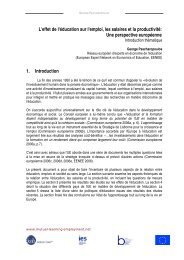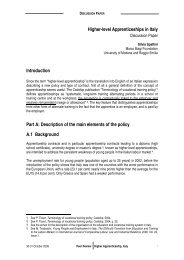The Active Labour Market Policy Reform – The Second Wave
The Active Labour Market Policy Reform – The Second Wave
The Active Labour Market Policy Reform – The Second Wave
Create successful ePaper yourself
Turn your PDF publications into a flip-book with our unique Google optimized e-Paper software.
4. <strong>Policy</strong> impact and challenges<br />
May 13-14, 2004<br />
EXECUTIVE SUMMARY<br />
In the following section, the strengths and weaknesses of the reforms as they were<br />
discussed in the expert papers and during the Peer Review meeting will be looked at.<br />
As mentioned above, the overall results of both the first and the second wave of reforms<br />
have been positive although the second wave has only just started. In the case of the latter,<br />
it is perhaps more accurate to speak of an assessment of the concept than of the results 6 .<br />
<strong>The</strong> two-strand - and emerging three-strand - approach has the advantage of being able to<br />
address the needs of the different segments of the labour market in a more focused and<br />
qualified manner. On the one hand, the more independent, better-qualified members of the<br />
labour market and employers benefit from the self-service systems and e-services in place<br />
and, on the other, the harder-to-place customers benefit from the personalised, holistic<br />
services offered in the framework of the LAFOS. <strong>The</strong> most impressive result has been the<br />
halving of the stock of long-term unemployed from 140,000 in 1996/97 to 70,000 at present.<br />
<strong>The</strong> efforts being made to react to the ageing and shrinking workforce are also promising<br />
and will no doubt gain in importance when the generation change begins to make itself felt.<br />
<strong>The</strong> most obvious challenge to the reforms is maintaining a link between the first two strands<br />
and avoiding fragmentation between the services of the PES and the LAFOS. Linked to the<br />
further development and increase in number of the LAFOS is the problem of how to handle<br />
the service chains between employment offices, LAFOS and subcontractors. Such service<br />
chains are vulnerable to breakdowns and this could result in customers again being sent<br />
from one provider to the other and again resorting to social benefits, which puts a strain on<br />
municipal budgets.<br />
In this dual system, there is also the question of how to assess and refer customers<br />
satisfactorily. This is done by the local PES staff in co-operation with the customers but is a<br />
sensitive issue. <strong>The</strong>re is also a need for ‘job-readiness indicators’.<br />
A further weakness, or challenge, is the management of the LAFOS. As mentioned above,<br />
there are difficulties involved in the management of an organisation ‘owned’ by three<br />
different partners and the position of the LAFOS within the local and regional strategies is<br />
not yet clear. <strong>The</strong> problems are also of a very practical nature, e.g. the IT systems of the<br />
state and municipalities are not compatible. It will also be difficult to evaluate the impact of<br />
the LAFOS because the management and follow-up systems established in the era of<br />
management by results are inadequate. <strong>The</strong> greatest danger to the new system would be for<br />
the LAFOS to lose contact with the other strands and to be left to deal with the most difficult<br />
customers alone. This would result in the kind of structural unemployment which the new<br />
dual system was meant to deal with.<br />
6 Robert Arnkil, <strong>The</strong> <strong>Second</strong> <strong>Wave</strong> of <strong>Active</strong> <strong>Labour</strong> <strong>Market</strong> <strong>Policy</strong> <strong>Reform</strong>s in Finland, Independent Expert Paper,<br />
Peer Review Programme, 2004.<br />
Peer Review <strong>The</strong> <strong>Active</strong> <strong>Labour</strong> <strong>Market</strong> <strong>Policy</strong> <strong>Reform</strong> <strong>–</strong><br />
<strong>The</strong> <strong>Second</strong> <strong>Wave</strong><br />
7





